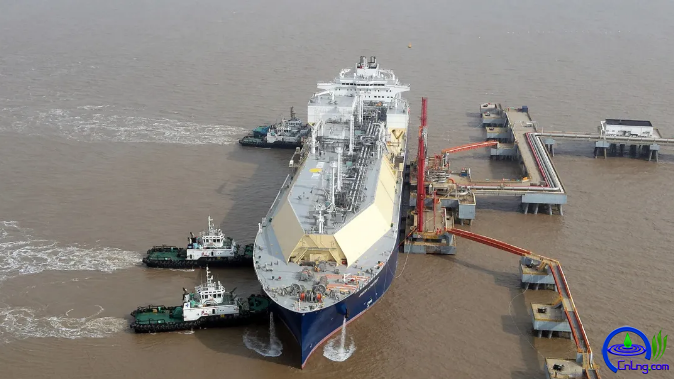免职声明:本网站为公益性网站,部分信息来自网络,如果涉及贵网站的知识产权,请及时反馈,我们承诺第一时间删除!
This website is a public welfare website, part of the information from the Internet, if it involves the intellectual property rights of your website, please timely feedback, we promise to delete the first time.
电话Tel: 19550540085: QQ号: 929496072 or 邮箱Email: Lng@vip.qq.com
摘要:据统计,2024年一季度南通海事局已保障广汇吕四LNG分销转运站安全接卸液化天然气78.2万方,气化后容量约为4.89亿立方米,满足了约200万户三口之家1年的用气需求,为华东地区天然气供应稳定夯实基础。据了解,“武当”号LNG运输船为沪东中华造船(集团)有限公司联合..
|
据统计,2024年一季度南通海事局已保障广汇吕四LNG分销转运站安全接卸液化天然气78.2万方,气化后容量约为4.89亿立方米,满足了约200万户三口之家1年的用气需求,为华东地区天然气供应稳定夯实基础。
该船船长295米、宽45米、深26.25米,航速为19.5节,入级劳氏船级社(LR)和中国船级社(CCS),具有蒸发率低、能耗低、可靠性高、环保性高、通用性强、前瞻性好、经济性优等亮点,各项性能均达到国际先进水平。 为切实保障辖区LNG等重要能源物资运输安全,南通海事局从服务地方经济发展、保障居民生活需要出发,统筹做好水路运输安全生产、恶劣天气防抗和保供保畅工作,在提升LNG船舶进出港及码头周转效率的同时,有效保障了重点物资供应链稳定畅通。 作为中国沿海第12座、江苏第2座、国内首个民企投资的LNG接收站,广汇能源启东LNG接收站目前已建成投运2座5万方LNG储罐、2座16万方LNG储罐、2座20万方LNG储罐及配套设施,总罐容82万方,自2017年运营以来,在南通海事局安全监护下,广汇能源启东LNG接收站已完成150艘次LNG运输船靠泊作业,安全接卸液化天然气821.51万吨(约1864.83万方),为华东地区提供了稳定可靠的LNG应急调峰气源,切实保障了区域市场供应、应急调峰及工业用气需求。 According to statistics, in the first quarter of 2024, Nantong Maritime Safety Administration has guaranteed the safe handling and unloading of 782,000 square meters of LNG at Guanghui Lusi LNG distribution and transfer Station, with a capacity of about 489 million cubic meters after gasification, meeting the gas demand of about 2 million households of three for one year, and laying a solid foundation for the stable supply of natural gas in East China. It is understood that the "Wudang" LNG carrier is the second 174,000 cubic meter large liquefied natural gas (LNG) carrier built by Hudong Zhonghua Shipbuilding (Group) Co., Ltd. and China Shipbuilding Industry Trading Co., Ltd. for the COSCO Shipping China National Petroleum LNG transportation project, which is the practice of national energy development strategy and the implementation of the "national gas national transportation". A masterpiece of the "national wheel" policy, its sister ships also have the "Shaolin" wheel, "Emei" wheel and "Kunlun" wheel, whose name is inspired by the martial arts school. The ship is 295 meters long, 45 meters wide, 26.25 meters deep, and has a speed of 19.5 knots. It is classified by Lloyd's Register of Shipping (LR) and China Classification Society (CCS), with low evaporation rate, low energy consumption, high reliability, high environmental protection, strong versatility, good foresight, excellent economy and other highlights, and its performance has reached the international advanced level. In order to effectively ensure the safety of transportation of important energy materials such as LNG in its jurisdiction, Nantong Maritime Safety Administration, starting from serving local economic development and ensuring the needs of residents, has coordinated the safe production of waterway transportation, the prevention and resistance of bad weather and the protection of supply and smooth, and has effectively ensured the stable and smooth supply chain of key materials while improving the turnover efficiency of LNG vessels entering and leaving ports and terminals. As the 12th LNG receiving station in coastal China, the second in Jiangsu Province and the first privately invested LNG receiving station in China, Guanghui Energy Qidong LNG Receiving Station has built and put into operation two 50,000-square-meter LNG storage tanks, two 160,000-square-meter LNG storage tanks, two 200,000-square-meter LNG storage tanks and supporting facilities, with a total tank capacity of 820,000 square meters. Under the safety supervision of Nantong Maritime Safety Administration, Guanghui Energy Qidong LNG Receiving Station has completed the berthing operation of 150 LNG carriers, and safely received and unloaded 8.2151 million tons of LNG (about 18.6483 million square meters), providing a stable and reliable LNG emergency peak balancing gas source for East China, and effectively guaranteeing the regional market supply, emergency peak balancing and industrial gas demand. |




 据了解,“武当”号LNG运输船为沪东中华造船(集团)有限公司联合中国船舶工业贸易有限公司为中远海运中石油国事 LNG 运输项目建造的第二艘 17.4 万立方米大型液化天然气(LNG)运输船,是践行国家能源发展战略,贯彻“国气国运,国轮国造”方针的力作,其姊妹船还有“少林”轮、“峨眉”轮和“昆仑”轮,取名灵感均来自于武侠门派。
据了解,“武当”号LNG运输船为沪东中华造船(集团)有限公司联合中国船舶工业贸易有限公司为中远海运中石油国事 LNG 运输项目建造的第二艘 17.4 万立方米大型液化天然气(LNG)运输船,是践行国家能源发展战略,贯彻“国气国运,国轮国造”方针的力作,其姊妹船还有“少林”轮、“峨眉”轮和“昆仑”轮,取名灵感均来自于武侠门派。







